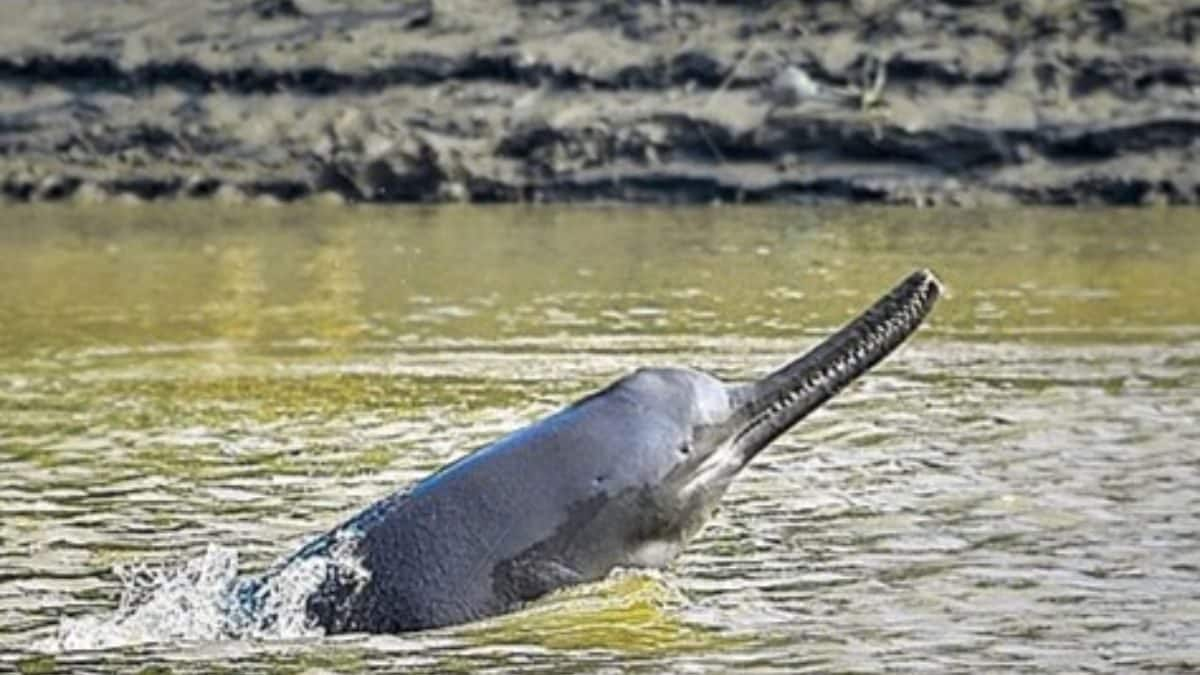The Gangetic dolphin, a critically endangered species, faces an ever-present threat in the form of habitat loss and pollution. However, in a recent incident, a different kind of peril unfolded – a group of dolphins got stranded in a receding canal, prompting a unique rescue operation in the state of Uttar Pradesh, India. This event underscores the precarious state of these animals and highlights the challenges they face in an increasingly disrupted ecosystem.
A Canal’s Tale: Dolphins Stranded and Rescue Efforts
The story unfolded in Mohanlalganj, Lucknow, when a canal breach in nearby Sitapur district caused flooding in villages. The irrigation department responded by reducing the canal’s water flow, but this had a dire consequence for seven Gangetic dolphins residing in the canal. With the water level drastically receding, they were left stranded in the shallows, struggling for oxygen.
The Forest Department promptly mobilized three teams of foresters, launching a rescue operation. Their immediate priority was the dolphins’ safety. Contacting the irrigation department, they facilitated the release of additional water, restoring the canal’s water level to provide a more suitable environment for the dolphins.
The Challenge of Rescue: Balancing Safety and Survival
With the immediate threat mitigated, the forest department moved towards planning a long-term solution. Two options emerged: physically rescuing the dolphins and relocating them to another river or allowing them to navigate back to their original habitat naturally. The first option carried a higher risk of mortality, estimated at 30%. The second, while demanding patience and careful monitoring, presented a lower mortality rate and was deemed the safer approach.
The Forest Department deployed their teams at the site, not only to monitor the dolphins and ensure their safe passage back to the Sharda River (250 km away) but also to keep poachers at bay. The presence of the foresters would also allow for continual observation of the fluctuating water levels and address any potential issues as they arose.
A Recurring Problem: Dolphins Stranded in UP’s Canals
This isn’t an isolated incident. In May 2023, a dozen dolphins, including calves, were rescued and redirected back to the Ghaghra River after getting stranded in the Sharda Canal. In 2018, a seven-foot dolphin was rescued from the Indira Canal, though it tragically succumbed later, emphasizing the fragility of these animals even during rescue operations.
These incidents reveal the vulnerable state of Gangetic dolphins, particularly when their natural habitats are altered due to human intervention, such as dam construction and water management practices that create isolated pockets of water within the canal system.
Gangetic Dolphins: A Unique and Endangered Species
Gangetic dolphins, designated as the state’s official aquatic species, play a vital role in the Ganges River ecosystem. Their presence indicates a healthy, clean water environment, as they cannot survive in polluted waters. Their unique biology, including their inability to lay eggs and low fertility rate, further highlights their vulnerability.
Gangetic dolphins are recognized internationally for their importance. They hold protected status under India’s Wildlife Protection Act (1972), and they are listed as endangered by the International Union for Conservation of Nature (IUCN). The Convention on International Trade in Endangered Species (CITES) and the Convention on Migratory Species (CMS) also highlight their precarious status, reinforcing the urgent need for conservation.
A Critical Moment for Gangetic Dolphin Conservation
The recent dolphin stranding in the Mohanlalganj canal underscores the need for a comprehensive and proactive approach to their conservation. While immediate rescue efforts are crucial, the focus must expand to address the underlying issues:
1. Sustainable Water Management: The need for better water management practices is paramount, particularly in canal systems. Balancing human needs with the ecological well-being of the Gangetic dolphin requires careful planning and collaboration between irrigation departments, environmental organizations, and local communities.
2. Habitat Restoration: Efforts must be made to restore and maintain suitable habitat conditions for Gangetic dolphins, including reducing pollution, preventing dam construction that fragments waterways, and creating wildlife corridors to facilitate movement between rivers.
3. Raising Awareness: Public awareness campaigns can play a significant role in fostering empathy and understanding for the Gangetic dolphin and their plight. Educational programs, social media initiatives, and community outreach can be impactful tools in inspiring a sense of responsibility for protecting these vulnerable creatures.
4. Collaboration and Partnerships: Effective conservation demands strong partnerships between government agencies, conservation organizations, researchers, and local communities. By working together, they can establish comprehensive conservation plans, monitor dolphin populations, and address threats to their survival.
5. Enforcement and Monitoring: Strict enforcement of wildlife laws is essential to protect dolphins from poaching and habitat degradation. Continuous monitoring of populations and habitat health allows for early intervention and informed decision-making for conservation.
Takeaway Points
- The recent incident of Gangetic dolphin stranding in Uttar Pradesh highlights the ongoing challenges facing the species in a changing environment.
- Protecting Gangetic dolphins necessitates a multi-pronged approach that incorporates sustainable water management practices, habitat restoration efforts, public awareness initiatives, and collaboration amongst key stakeholders.
- It is crucial to recognize that the fate of Gangetic dolphins is intrinsically linked to the health of the Ganges River ecosystem. Protecting these animals requires a broader vision of environmental conservation.
- As an endangered species, Gangetic dolphins serve as an indicator of the overall health of the Ganga ecosystem, underscoring the need for urgent action to address pollution, habitat loss, and unsustainable water management practices.
- The commitment to protect the Gangetic dolphin goes beyond simply rescuing individuals in distress. It demands a long-term, holistic approach to address the root causes of their decline and safeguard the future of these fascinating and vulnerable creatures.









